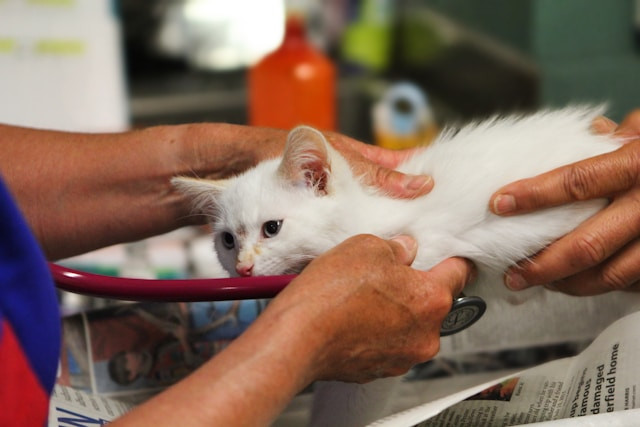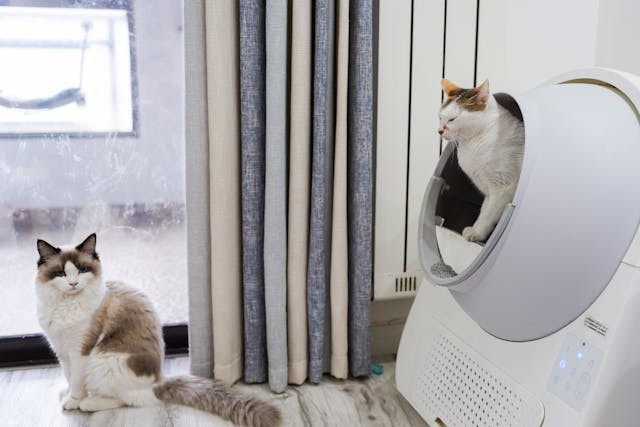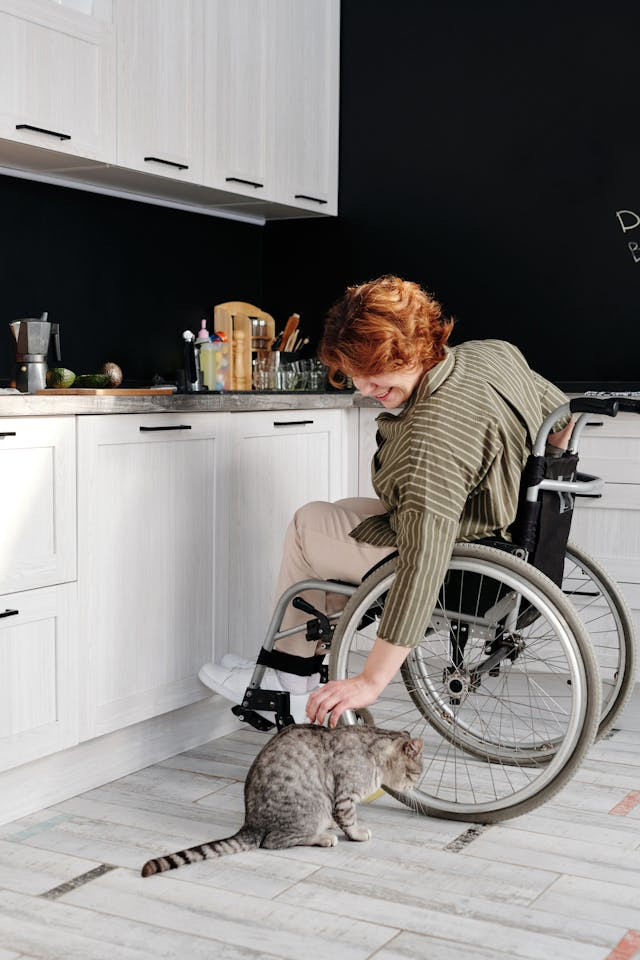As a cat parent, anything that promises to simplify your life is incredibly appealing. From automated food dispensers to easily washable rugs, the market is full of products designed to make cat care more convenient. However, not all pet products, especially in the realm of pet technology, are truly designed with your cat’s best interests at heart. While some innovations are genuinely helpful, others, like certain deterrent devices, can create more problems than they solve. Self-cleaning litter boxes, despite their promise of a hands-off approach to a necessary chore, often fall into this problematic category, at least in their current iterations. Many boast that you’ll never have to scoop cat litter again, but they often fail to mention the potential drawbacks and stress these devices can impose on your feline friend.
The Downsides of Self-Cleaning Litter Boxes for Cats
While there might be limited scenarios where a self-cleaning litter box could be considered a reasonable option, for the vast majority of cats, they are far from ideal. The disadvantages often outweigh the perceived benefits, ultimately catering more to human convenience than feline well-being. These devices, while marketed as time-savers for owners, can introduce a range of issues that negatively impact your cat’s litter box experience and overall comfort.
 A gray and white cat sits near a pine tree in a green grassy field.
A gray and white cat sits near a pine tree in a green grassy field.
A thoughtful grey and white cat contemplates the noise pollution from automatic litter boxes in a peaceful green field. Photo by Kaiwen Sun.
Noise Sensitivity
While the whirring and clicking of a self-cleaning litter box might seem relatively quiet to us, it’s crucial to remember that cats possess significantly more sensitive hearing than humans. This heightened auditory perception means sounds that are barely noticeable to us can be quite loud and startling to a cat. This is why placing a regular litter box near noisy appliances is discouraged, as the sudden activation of these appliances can deter a cat from using their litter box, potentially leading to aversion.
Robotic litter boxes, by their very nature, generate noise during their cleaning cycles. This operational noise can be frightening for cats, especially if the cleaning cycle initiates while they are nearby or even inside the box. Even if a cat isn’t physically in the box when it starts its self-cleaning process, the unexpected noise can create fear and anxiety associated with the litter box itself. Unfortunately, witnessing cats developing aversions to self-cleaning litter boxes due to noise-related stress is a common occurrence reported by cat owners and behaviorists alike.
Accessibility Issues
Many self-cleaning litter box designs incorporate features that, while perhaps intended for space-saving or aesthetic purposes, can present physical challenges for cats. These often involve requiring cats to navigate stairs or descend into an enclosed chamber to access the litter. While these might appear as minor obstacles to us, for cats, especially smaller breeds or those with mobility limitations, these features can represent significant hurdles. Remember, cats are considerably smaller than humans, so actions like climbing or stepping up require proportionally more effort.
As cats age, conditions like arthritis or general stiffness become more prevalent, making it increasingly painful and difficult for them to climb in and out of robotic litter boxes, even those equipped with ramps. Senior cats thrive with easily accessible litter boxes, and ramps on self-cleaning models often prove to be too steep or uncomfortable for their aging joints. Even younger, more agile cats might be discouraged by the extra effort required to use these boxes, potentially leading them to seek out easier elimination spots, such as your floor, which is undeniably more accessible than a self-cleaning litter box. This is a frequent complaint from owners who find their cats eliminating right next to their high-tech, self-scooping litter box.
Limited Litter Choices
Self-cleaning litter boxes are designed to function with specific types of litter that are compatible with their automated cleaning mechanisms. This necessary compatibility often translates to a restricted selection of litter options. However, cats are known to have distinct preferences when it comes to litter texture, scent, and composition. If the types of litter recommended or required for a self-cleaning box are not to your cat’s liking, it can easily lead to litter box avoidance. If your cat dislikes the feel or smell of the litter, they are highly likely to stop using the box altogether. Are you noticing a recurring theme here? Many of the purported benefits of self-cleaning litter boxes are quickly negated if your cat refuses to use them in the first place.
Hindered Health Monitoring
While some higher-end robotic litter boxes boast health monitoring features, these often focus on data points that are either readily observable through traditional scooping or not as critical as direct visual assessment of your cat’s waste. One of the often-overlooked advantages of manually scooping a litter box is the opportunity it provides to monitor your cat’s health. By directly observing the urine and feces during scooping, you gain valuable insights into their well-being. Switching to a self-cleaning system can mean missing out on these crucial, and often free, health indicators.
Two prominent examples of health concerns that can be easily missed or delayed in detection with self-cleaning boxes are blood in the urine and changes in stool odor. Blood in a cat’s urine (hematuria) can be a sign of serious underlying conditions, such as urinary tract infections, bladder stones, or even more severe issues. Similarly, a change in the odor of your cat’s feces can be an early indicator of gastrointestinal problems, such as parasitic infections like giardia. These subtle changes are often readily apparent during manual scooping but can be easily overlooked or obscured by the automated cleaning cycles and waste disposal systems of self-cleaning litter boxes.
Better Ways to Monitor Cat Health
Despite the marketing claims of self-cleaning litter box manufacturers regarding health monitoring benefits, more effective and cat-friendly methods exist for tracking your feline companion’s well-being. As unpleasant as it may seem, directly observing your cat’s litter box habits, urine, and feces remains the gold standard for health monitoring. This direct observation provides a wealth of information that automated systems often cannot replicate.
 A cat
A cat
A concerned tabby cat emphasizes the importance of regular vet check-ups for optimal health monitoring, much better than relying on a self-cleaning litter box. Photo by Judy Beth Morris.
Regular veterinary check-ups are also paramount for proactive health management. These professional examinations allow for early detection of potential health issues, often before they become visibly apparent in litter box habits. If you’re interested in leveraging technology to assist with health monitoring without compromising your cat’s litter box experience, consider a health monitoring platform designed for regular litter boxes. These systems can track weight, frequency of visits, and other metrics without the drawbacks of self-cleaning mechanisms. Similarly, a freestanding pet scale offers a simple and accurate way to monitor your cat’s weight, a key indicator of overall health. Ultimately, relying solely on a self-cleaning litter box for health monitoring is not the most comprehensive or reliable approach.
If your primary concern is tracking litter box usage frequency, placing the litter box in a more visible location (which is generally recommended anyway) or setting up an indoor camera with motion detection provides a much more affordable and less intrusive solution. Indoor security cameras, readily available from brands like Eufy, can offer motion detection alerts without monthly subscription fees, allowing you to monitor litter box visits discreetly. Cats are generally unconcerned about being observed during their bathroom breaks, so a camera is unlikely to cause them stress.
Stress in Multi-Cat Homes
Many self-cleaning litter boxes are designed with space-saving in mind, often resulting in smaller overall dimensions and enclosed designs. However, cats generally prefer larger litter boxes that provide ample space for them to comfortably turn around, dig, and eliminate. The constricted entrances and limited interior space of many self-cleaning models can be particularly problematic in multi-cat households. Despite some manufacturers claiming their products are suitable for multiple cats, this is often not the reality.
 An unhappy cat in a self cleaning litter box with another cat out front
An unhappy cat in a self cleaning litter box with another cat out front
A tense standoff at a self-cleaning litter box, highlighting potential territorial stress between cats in a multi-cat household. Photo by Nicholas Fu.
In homes with cat conflict or territorial dynamics, a self-cleaning litter box can become a source of stress and even aggression. The enclosed nature and single entrance/exit point can easily create a situation where one cat feels cornered by another. If one cat blocks the entrance, intentionally or unintentionally, the cat inside the box can feel trapped and vulnerable. This can escalate existing tensions, leading to litter box avoidance or even outright cat fights. Even if direct cornering doesn’t occur, in a multi-cat environment, another cat simply walking past the enclosed litter box entrance might be perceived as a threat by the cat inside, triggering defensive behaviors or prompting them to eliminate elsewhere to avoid potential confrontation.
When Might a Cat Self Cleaning Litter Box Be Acceptable?
It’s important to acknowledge that self-cleaning litter boxes are not entirely without merit. They hold the potential to simplify pet care for humans. However, it’s crucial to reiterate that the current generation of self-cleaning litter boxes on the market falls short of being truly cat-friendly or universally beneficial. The fact that no specific brands have been named in this discussion is intentional, as the issues highlighted are prevalent across the majority of available models. This list isn’t exhaustive, and further concerns exist regarding the safety and longevity of some robotic litter box designs.
Exceptionally Clean Cats
From a cat-centric perspective, there are very limited situations where a self-cleaning litter box might be considered a potentially acceptable, or perhaps less-than-ideal but workable, option. One such scenario involves cats that are excessively fastidious about litter box cleanliness. Some cats exhibit such extreme sensitivity to even slightly soiled litter that they will refuse to use the box unless it is impeccably clean. In these very specific cases, a self-scooping litter box might be considered as a last resort.
However, before resorting to a robotic solution, it’s always advisable to explore simpler and more cat-friendly alternatives. A Litter Genie or similar waste disposal system can encourage more frequent manual scooping, making it easier to maintain a consistently clean litter box for a finicky cat. Alternatively, setting up a second litter box right next to the primary one provides a clean backup option and gives owners more time between scooping sessions. If these less invasive approaches fail to satisfy an exceptionally cleanliness-focused cat, then, and only then, might a self-scooping box be cautiously considered, with careful monitoring of the cat’s reaction. Even then, it’s not a guaranteed solution. If your cat is exhibiting litter box avoidance, it’s crucial not to automatically assume they need a self-cleaning litter box. In most cases, litter box problems are not solved by these devices, and often, the issue either begins or worsens with the introduction of a self-scooping system.
Helping With Disabilities
Another situation where a self-cleaning litter box can be genuinely beneficial is when a human’s disability significantly limits their ability to perform regular litter box cleaning. For individuals with mobility impairments, chronic pain, or other physical limitations that make scooping difficult or impossible, a self-scooping litter box can be a valuable aid. Everyone, including those with disabilities, deserves to experience the companionship and joy of having a cat. If a less-than-perfect piece of pet technology can enable someone to care for a cat when they otherwise couldn’t, it becomes a much more justifiable option.
 A woman in a wheelchair pets a cat
A woman in a wheelchair pets a cat
A heartwarming scene of a cat providing comfort and companionship to a woman in a wheelchair, illustrating that everyone deserves the joy of cat ownership, even with litter box challenges. Photo by Marcus Aurelius.
However, even in these circumstances, it’s essential to acknowledge the potential risks of cat aversion and explore alternative solutions first. Long-handled litter scoops can significantly reduce the need to bend over, making scooping more accessible for individuals with back pain or mobility issues. Ergonomic scoop designs with specialized handles can also improve grip and reduce strain. Scoops with built-in waste containers or temporary storage compartments can further simplify the scooping process. Modifying traditional scoops or exploring adaptive tools might provide effective solutions that allow disabled individuals to meet their cat’s litter box needs without resorting to a self-cleaning system that could potentially stress the cat. Numerous alternatives to self-cleaning litter boxes exist that prioritize both the cat’s well-being and the owner’s capabilities.
(A Lot Of) Room For Improvement
Even in the limited scenarios where self-cleaning litter boxes offer some advantages, the technology currently available is far from ideal, especially when more affordable and cat-friendly solutions exist. The fundamental flaw lies in the design philosophy: self-cleaning litter boxes need to be engineered with both human and feline needs in mind. When cat welfare is not prioritized in the design process, the risk of litter box aversion and related behavioral problems significantly increases.
For most cat owners, self-cleaning litter boxes are not recommended. However, constructive dialogue with pet product businesses developing these devices is encouraged to advocate for cat-centric design improvements. The challenge to companies manufacturing self-scooping litter boxes is clear: create a better product that cats actually like. When a product costing hundreds of dollars is easily outperformed by a DIY litter box solution that cat owners can create themselves for under $20, a significant design overhaul is clearly needed.
For the time being, if you are considering a robotic litter box, it’s generally advisable to skip it. Seeking guidance to address the specific aspects of litter box maintenance you find challenging is a more prudent approach. Exploring solutions that balance your preferences with your cat’s needs will ultimately lead to a happier and healthier outcome for both you and your feline companion.
Need help getting your cat to use the litter box?
Set Up a Consultation


